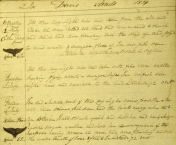Whaling Home | Following the Hunt | Next
The Whaling Season
The whaling season was traditionally begun at the beginning of May. By this time the ice pack was beginning to melt and retreat and this allowed the whaling ships access to the hunting grounds. On board duties had been carried out during the Atlantic crossing and the equipment would be ready and stowed in each boat. The boat's crews were usually chosen by boat commanders, who drew lots in turn. This meant that expertise was spread evenly throughout the fleet. Each whaleboat would be hung ready for immediate launch from davits along the ships rail.

When the call A fall! A fall! came from the masthead lookout in the crow's nest, pandemonium would break out as the seamen rushed to their stations in the boats. Woe betides any latecomer who might delay launch, because a bonus was available to the boat that made the first strike. There was no nine to five routine, a watch was kept 24 hours a day and if whales were in the vicinity the hunt would continue for as long as they remained. It was not unknown for a whaler to have 3 or 4 whales alongside. With the boats launched the crews would row as quietly as possible to get close to the whale. The trick was to approach from behind and slightly to one side and if possible bump its body with the bow of the whaleboat frightening it so that its back arched as it dived. This presented the harpooner with a clear target at which to aim. The tight skin meant that the harpoon would penetrate more easily and grip better so the whale was less likely to escape.